Want to jump straight to the answer? The best blogging platform for most people is definitely Wix.
When it comes to creating your own blog, you have two options:
The first is to build a website and host your blog there. Building your own website and blogging on it is the old-school way to build a blog. To do this, you’ll need to use software like Wix or do everything yourself through WordPress.
This requires more work upfront but you’ll own and control your site completely.
The other option is to use a blogging platform like Medium, LinkedIn, Facebook, or Instagram. Even if some of these platforms aren’t technically blog platforms, you can get more success from them by treating them as blogs. It’s a lot easier to get in front of millions of people and takes less than 15 minutes to set up. The downside is that you’ll be beholden to their rules and algorithms.
In this guide, I’ll break down both ways to set up your blog and help you pick which blog site, software, or blogging platform is best for you. Let’s get to it.
How to Choose the Best Blogging Platform for You
To figure out the right platform to you, we need to take a look at two very important questions: Do you want to make money and what’s your blogging niche?
1. Do you plan to make money blogging?
If so, go with Wix.
Wix has all the features you’ll need to make money with your blog. It’s also easier to use than other platforms.
• 14-day free trial
• Drag and drop site builder
• Integrated payment processing
• 500+ ecommerce templates
• Try Wix for Free
If you’re not trying to make money blogging, use one of the best blog sites I list below instead.
These blog sites are great if you aren’t trying to create an income because:
- They have built-in audiences
- They’re free to use
My recommendation for which one to choose is based on the outcome that you’re trying to achieve. Which leads me to my next question:
2. What’s your blog about? Who will read it? What is your blog niche?
My recommendations:
- If you’re in business, blog on LinkedIn.
- If you’re creative, start your “blog” on Instagram.
- The best classic blogging site is Medium, which can also serve as a syndication platform.
- The biggest audience, of course, still lives on Facebook.
If you hadn’t thought about creating your blog on anything other than a website builder, it might be kind of hard to wrap your mind around these blog sites. I’m not saying they’re best for every blog, but they’re a great way to go if your audience already spends time on those platforms.
No matter what, research your audience first. See whether a social platform might be a better fit for them than a traditional “blog.” I often recommend that designers, photographers, and artists skip blogging entirely and go straight to Instagram, where their audience would expect to see their work.
Reviews of the Top 6 Best Blogging Platforms and Blog Sites for 2020
Here are our in-depth reviews of the most popular blog platforms.
Wix – Best Website Builder for Blogging
Wix is the best website builder for blogging. No question.
If you want to go the easy route for owning your own blog, this is it. It’s an easy runner up to WordPress for the best blog platform.
That’s because it’s incredibly simple and easy to use.
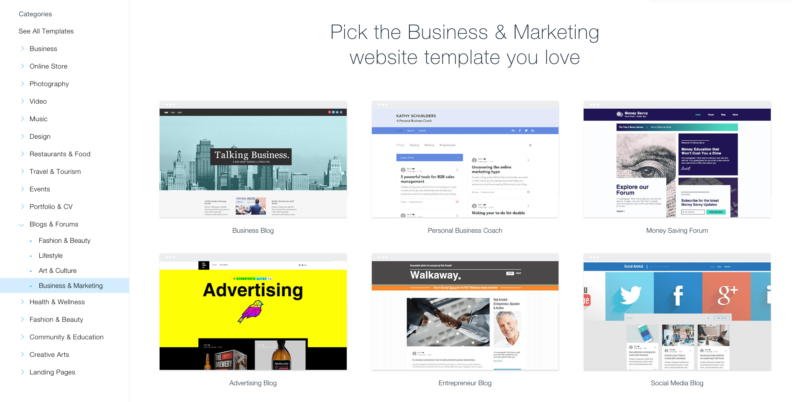
It comes with beautiful templates for any type of blog. They’re also easily customizable with their drag-and-drop editor. The blog manager is simple and intuitive, and you’ll get analytics and SEO built right in. It’s simple to add the basic features you might want on your blog: social tools, likes, comments, hashtags, categories, and subscriber forms.
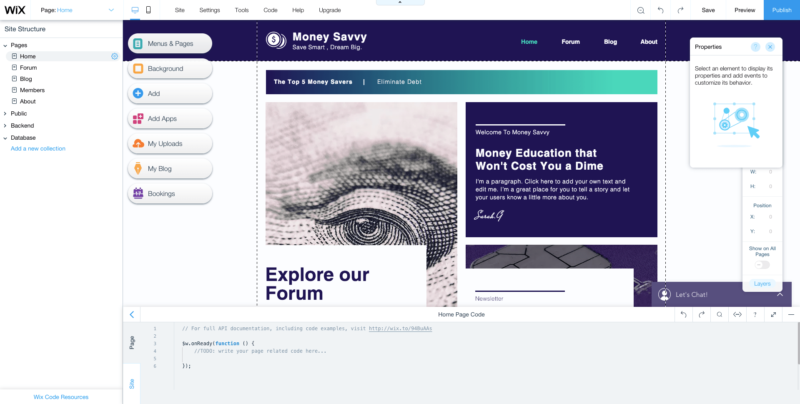
All of the SEO features you need are easy to access too: alt tags for your images, internal links, SEO titles and descriptions (that are different from you post title), and nofollow tags for external links. Wix blogs have an automatic email subscription feature and a social media bar beneath each article for sharing on Facebook, Twitter, and more.
To build a blog on Wix, you’ll sign into your account and pick a template. There’s a Blog template category, which is a great place to start. Once you have your template selected, I suggest updating the font, colors, and logo to personalize your template and help it stand out from the rest.
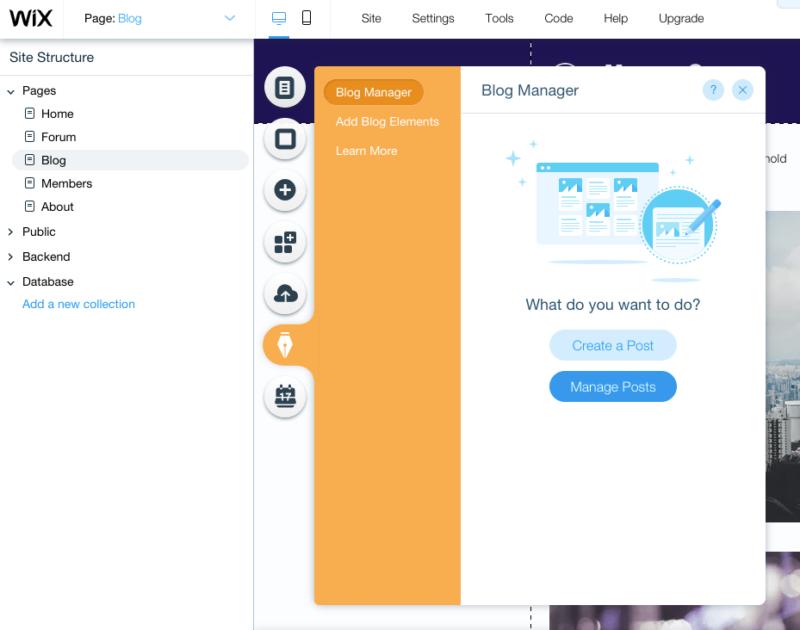
Writing a post is as simple as clicking Create a Post, writing, and adding images. You can save drafts, or even give other contributors writing privileges for your site. This is all just as easy from a mobile device as from a desktop — no app required.
Make sure that you update your SEO settings for every post: this is what’s presented in the search results page and is critical for ranking in organic search.
The resulting post will have an automatic read-time count, like a Medium post right next to the author’s name, which I also like a lot. I also like the ability to live-chat with your readers in the Wix app. If you build a real community in your blog or are open to answering reader questions in real time — say about an online course you’re offering or a webinar that’s coming up — then it’s a cool feature.
Pros and Cons of Creating a Wix Blog
Wix is a fantastic option if you want a simple, but powerful blogging platform. With its drag-and-drop website builder, it’s an easy option if you’re looking to have your blog on your own site, rather than on a blog platform or service like Medium or another form of social media.
The downside is you’ll be paying a subscription fee and you’ll be locked into Wix’s themes and tools. So, you’ll trade some convenience for some flexibility. For most users, we think this trade-off is worth it.
• 14-day free trial
• Drag and drop site builder
• Integrated payment processing
• 500+ ecommerce templates
• Try Wix for Free
WordPress – Best Blogging Software for Flexibility
WordPress by far the most flexible option. No matter what you want from your blog, it can be done with WordPress.
They’re also one of the most popular website builders in the world. So you’ll be in good company if you use it.
To build your own site, you’ll need to buy a domain name, get web hosting, and set up your WordPress account. There’s more information on our post The Best Web Hosting and on The Best Web Hosting for WordPress, which is about selecting a managed host that’s designed for WordPress.
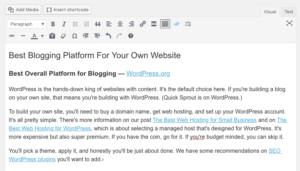
You will need to spend time configuring your site, that includes picking a theme, configuring it, setting up your WordPress settings, adding SEO WordPress plugins, getting all your content uploaded. For first-time bloggers, it can be overwhelming.
That’s the trade-off with WordPress. It’ll do anything you want but it takes more time to learn than an easier platform like Wix.
Pros and Cons of Blogging with WordPress
The main reason to use WordPress is for its complete flexibility. No matter what you want to build or how big you get, WordPress can handle it. This is the biggest benefit of using WordPress.
There are millions of plugins that give you all sorts of extra features. And if you really want, you can start changing the code yourself. WordPress is open-source which means you can do whatever you want with it. If you know PHP or are willing to hire a developer, you can change WordPress however you like.
But with such flexibility comes a lot of learning. You have to learn WordPress, the plugins, your theme, and how to write posts well. It’s a lot to take in when building your first site. If you just want to launch your site so you can start blogging right away, WordPress won’t be the easiest option.
Medium – Best Traditional Blogging Site
It’s hard to pin down how many users Medium has — they focus on sharing how much time is spent on the platform reading instead. I dig it. The platform, was founded by Twitter co-founder and former CEO Evan Williams as a response to the hyper-short limits of Twitter, hence the name Medium. 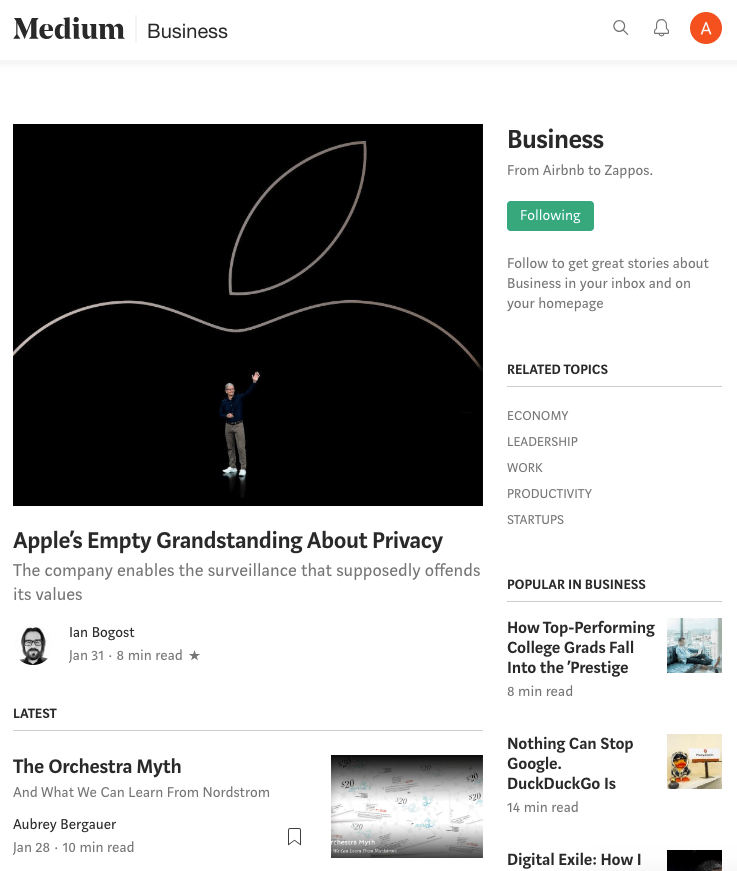
At one point, there was some distinction between even longer blog platforms, but that’s dissipated by now.
In 2017, Medium had 60 million unique visitors. From personal experience, I know that when I read on Medium, I read with curiosity and intent. I’m ready to put in some time reading, and the read times on each article get me to commit to sticking it out for the whole thing.
Posting with Medium is super simple. There’s a clean, very white WYSIWYG (what you see is what you get) editor. Basically, as you type, you see what the post will look like when it’s published. You’ll find that tips and tricks to format your post are a little hidden in the simplicity of the interface.
Don’t stop at this point though. Instead of just a profile, I recommend creating a Medium Publication. This gives you the option to add other writers and editors to your blog. More importantly, it gives you a lot more options for controlling what is essentially your blog homepage.
Take a look below at the difference between Patagonia’s basic Medium profile (top image below) and REI’s Medium publication (bottom image below).
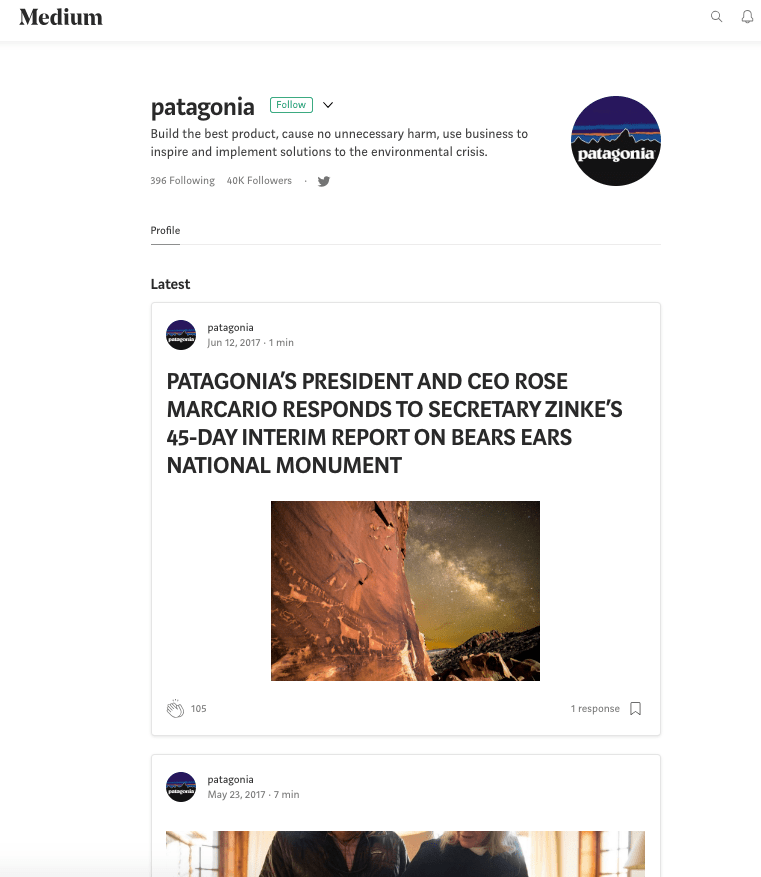
Above, a consecutive stream of your posts. This is all you’ll get with a Medium profile.
Below, the more magazine-style layout you’ll get with a Medium publication.
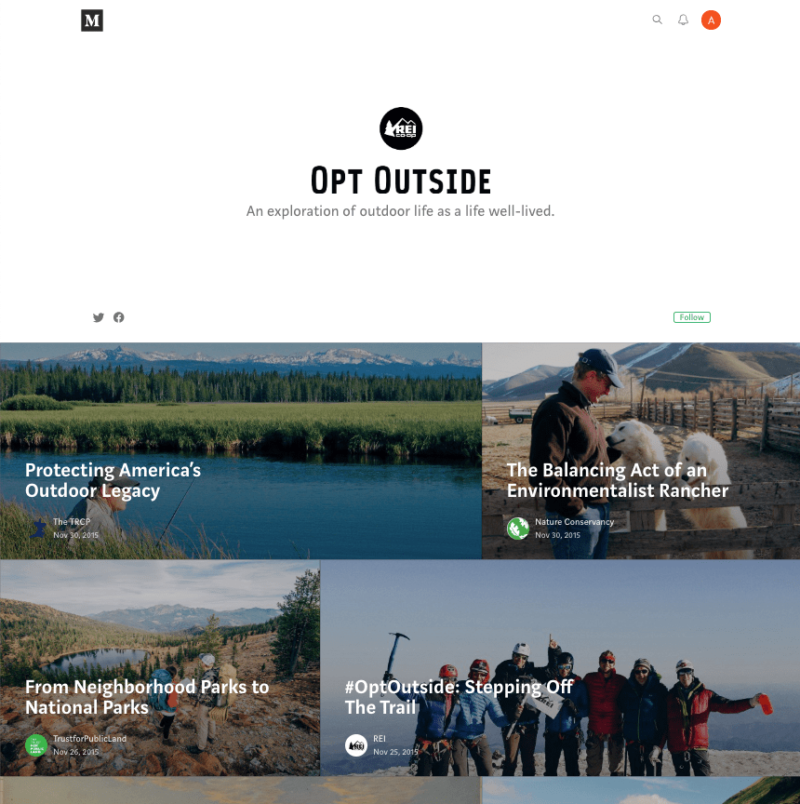
One is a simple chronological feed and the other is a designed page with useful menu options. When you create a publication like REI’s, you also unlock the ability to send a newsletter to all of your followers.
Pro Tips for Blogging on Medium
- If you are syndicating your actual blog, use the Import feature. This is essential for SEO.
- To start a bulleted list, simply type an asterisk or a dash.
- There are two types of quotes. Use a block quote by clicking the quote icon once. Click it again for a pull quote.
- Drop caps add a little editorial weight. To make the first letter of your paragraph larger, and give it that designed look, highlight the letter. The option will appear.
- Use TK to leave yourself notes. This is an old journalism trick — there are no words with TK in them in the English language. If you’re writing something that needs a placeholder, use TK and Medium will alert you if you try to publish with one still in place.
Pros and Cons of a Medium Blog
Medium is the best all-around traditional blogging platform. It’s where the majority of readers who’re looking to read classic blog-style posts are right now.
The downside is built into the choice of picking to create your own blog or build one on a platform — you won’t own the traffic and you won’t be able to do things like sell ad placements, for example.
Deciding to blog on WordPress vs Medium isn’t an either-or choice. You can also publish your site and re-publish some posts on Medium to take advantage of its benefits, just like you would any syndication deal. You can thoughtfully approach this, but there are some technical how-tos we’ll get into below. You’ll need to import your posts to Medium properly and set the canonical tag, so you’re not penalized by Google (at worst) or simply out-ranked by the Medium version of the post (at best). Overall, though, I prefer to see each channel as a separate channel and create and publish unique content for that channel.
LinkedIn – Best Blog Site for Business
There are 590 million LinkedIn users, 154 million of them in the US. And a lot of them are active: 44% are monthly active users. LinkedIn used to be basically a resume hosting platform. In a lot of ways, it was like a job-hunting dating app: you’d go on if you were looking to hire or looking to get hired but not much else. In the last few years that has changed dramatically.
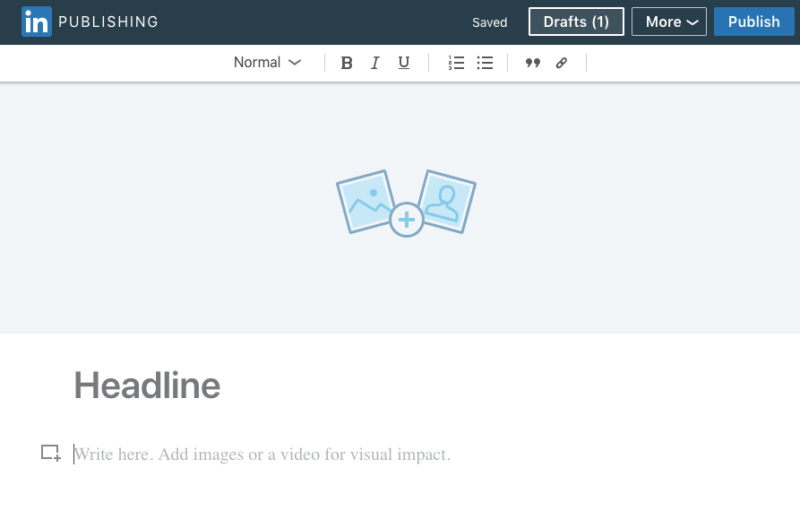
If you’re building a business blog, the audience on LinkedIn is premium: 45% of LinkedIn article readers are in upper-level positions (managers, VPs, Directors, C-level).
In an article for Forbes, “Is LinkedIn Poised To Be The Next Big Social Network … For Brands?”, Ryan Holmes nailed what’s great about the platform, “Hardcore LinkedIn users know that there’s a certain warm professionalism that underlies many exchanges on the platform. In short, LinkedIn offers a kind of stability, civility, and real value that’s sorely needed on some social platforms.” I completely concur. The platform has a ready-made culture and set of expectations that a business blogger would dream of creating on their own site. Why build it when it already exists?
LinkedIn is a social network. Your influence grows in proportion to the size of your network. The more posts you publish, the more connection requests and followers you’ll attract. Writing consistently not only expands your network, but it also reinforces the message about the depth and breadth of your knowledge of the subjects that you write about. — Glenn Leibowitz, “10 Tips for Writing LinkedIn Blog Posts That Expand Your Influence” for Inc.
Publishing doesn’t make you a LinkedIn Influencer, unfortunately. That’s a hand-selected group of people that rotates throughout the year “to include only the most engaged, prolific, and thoughtful contributors and to ensure that their expertise matches our members’ interests,” according to LinkedIn.
An article isn’t a post and vice versa. A post is a smaller update you’d share with your feed and connections. Think quick anecdote or pro tip. They’re limited to 1,300 characters, which is about 5 lines. Articles are longer and more in-depth. They’re something that the broader LinkedIn audience would be interested in reading. A person who reads your article can also follow you from there, so they’ll be alerted when you publish your next article. Any articles you publish will appear in the Articles section of your LinkedIn profile.
Pro Tips for Blogging on LinkedIn
- Be clear about who you are and what you’ll be talking about it. Stick to that topic and don’t stray. And post regularly. Even posting once or twice a month — consistently over time — will add up. Twice a month is 48 times a year. In five years, you’ll have nearly 250 posts. That’s huge.
- You can share a draft with a colleague or friend for feedback.
- Use the stats related to your posts as a tool: create more of what’s working, less of what’s not.
Want to improve? Check out LinkedIn’s own course on getting better at blogging on the platform, Writing to be Heard on LinkedIn. Because when they own the platform, what’s good for them is successful content that people want to read and engage with.
Pros and Cons of Blogging on LinkedIn
If you’re blogging about business, or something related, like management, then I’d say to build your blog on LinkedIn. There’s a pre-existing community of people there talking about those topics and ready to read your posts too. You’ll be able to build business followers, which is different than a “connection.”
The audience on LinkedIn is premium: 45% of LinkedIn article readers are in upper-level positions: managers, VPs, Directors, and C-level. If you’re building thought leadership, brand value, or community, rather than trying to make money, I recommend going to where your audience is rather than trying to woo them over to where you are. Build content for them where they already are and they’ll love you for it.
You’ll be able to build your network and your business opportunities, but like all blog platforms, the cons here are that you’re beholden to the algorithm and don’t own the site or the traffic.
Instagram – Best Blog Site for Creatives
Instagram is primarily visual — the feed is all the images or videos, and very little of the captions. You can use the caption field for your text, and users like a long caption. You’ll be capped at 2,200 characters or about 300 words.
Instagram is perfect if what you’re sharing is visual: a lifestyle, art, dance. Or if there’s some way to share it visually like in a how-to mini-video.
In fact, in a lot of ways, Instagram has killed the entire genre of lifestyle blogging.
It’s become a lot harder for upstart “bloggers” in the crowded yet lucrative fashion, beauty, wellness, and lifestyle spaces to build a following centered around their own blog. At the same time, social media platforms have given influencers more and more tools—including e-commerce, groups, and direct messaging—to keep them (and their followers) from going elsewhere online.
— Rosie Spinks, “Instagram Has Killed the Art of Lifestyle Blogging” on Quartzy
Instagram is so good now that it’s hard to want to go anywhere else. The downside is definitely that you’re beholden to the algorithm and the feed, and the changes the platform makes. On the flip side, you also don’t have to be the product manager, hire a developer, or build an audience from scratch. You’ll have to weigh the pros and cons yourself.
You can also host vlogs on Instagram Live — simply tap the camera icon (top left of the screen, or by swiping right from the Feed) and tap Live at the bottom. When you’re ready to actually go live, it’s as simple as tapping Go Live. You’ll be able to see the number of viewers you have at the top of the screen and comments will pop in at the bottom. When you’re done, tap End. From here, I recommend tapping “Save” to save it to your camera roll and tapping “Share” to add it to your story. It’ll live there for 24 hours to be replayed by anyone who wasn’t around when it was actually live.
Pro Tips for Instagram Blogs
- Pick a good name that’s catchy and easy to type — your name should make it clear what your whole feed is about.
- Stick to a niche.
- Have a visual point of view.
- Don’t stray. If you’re an artist, don’t post pictures of your salad for lunch. If you’re a food blogger, think twice before you post photos of your doodles.
- Post regularly! And engage.
You can only have one link in your profile, but with something like Linktree, you can add more links. I don’t think it’s a great idea to build a blog somewhere hoping to get your readers or followers to move from there to somewhere else on the regular. It’s feasible to get your Instagram followers to also subscribe to your newsletter, but it’s not really logical to hope they’ll leave Instagram after ever post and go read your blog. They’re scrolling through Instagram, not trying to read your website.
Think about your own behavior here — how much momentum does it take to get you to follow a link that leads away from the platform you’re in? For me, it takes a lot of work. There has to be something I really want to buy, or really, really want to read.
It’s more likely that I’ll follow someone on Instagram for a while and then one day I’ll buy something from that person, or follow them somewhere else. Instagram, and all blogging really, is about creating a relationship with the people who’re reading your posts. Once that relationship is strong enough, then people will be interested in going wherever you’re taking them. Until then, you’ll need to deliver on that relationship within the platform itself.
Pros and Cons of an Instagram “Blog”
If you’re a creative — especially in a visual field, then your blog should really be an Instagram account. You can post images of your work and use the caption field for your written post. If you’re not used to this idea, it might seem kind of zany: That’s not a real blog. But it is. People read Instagram captions of the accounts they follow like they’d read a blog — and your visual work will be well highlighted in your feed and the general feed. The cons are self-explanatory: you’ll have to follow the Instagram format, and are subject to the feed’s algorithm. It’s not impossible to monetize your Instagram feed, but you’ll be limited to those that you can feature in an image or caption. All of the monetization opportunities will need to be natively integrated.
Facebook – Biggest Blog Audience
1.49 billion daily active users is a number worth noting. How many of those active users will make it to your page or your post, now that’s another question.
Organic reach on Facebook was once not such a wild aspiration, but in 2016 there was a huge decrease in organic reach. SocialFlow found that brands saw a 42% decline in organic reach over Q1 and Q2 2016.
The easiest way to build a blog on Facebook is to create a group or a page for your business or brand. From there, your posts will literally be Facebook posts.
To make it easier to post and handle all your interactions in one spot, I recommend using the Facebook Creator Studio. It’s an all-in-one dashboard for publishing and analyzing your content. If you’re new to Facebook and are really using it as a classic blog platform, you’ll want to create Notes. These are the closest things to blogs: a header image, a title, and text down the middle.
From here you can also go live, post videos, gifs, polls, recommendations — any type of Facebook post you’ve seen you can create from this dashboard. You can even save, schedule, and backdate posts.
Pros and Cons of Blogging on Facebook
Of course, Facebook is the juggernaut in the room. It has the largest audience of any of these platforms. Creating a Facebook page might be all you need to build a blog — post on Facebook like you would on your blog and build your audience right there on your page. The comments and interactions on Facebook are even better than a traditional blog. You can really focus on building true fans on Facebook.
The cons of Facebook have really been blasted through the media lately. There are privacy concerns, there’s the issue of an ever-changing and pretty secretive algorithm, and all of that. You probably already have an opinion of Facebook — let that inform your decision here.
If you build your blog on a single platform that you do not own, well, then you’ve built your blog on a single platform you do not own. That means you’re beholden to another person’s business and their algorithm for your business. What’s good for their business and algorithm may not be what’s good for yours. That’s why I say if you’re here to make money, you should own your site. You’ll have more control.
Recap of the 6 Best Blog Sites and Blog Platforms for 2020
Best Website Builder for Blogging — Wix
If you want control over your own site and keep things easy, go with Wix. It’s a drag-and-drop editor that’ll get you up and running quickly, and you’ll still be building your blog on your own website, not on someone else’s platform.
• 14-day free trial
• Drag and drop site builder
• Integrated payment processing
• 500+ ecommerce templates
• Try Wix for Free
Best Blog Software for Flexibility — WordPress
I’d recommend going this route to anyone serious about customizing your site and need complete control
Best Traditional Blogging Platform — Medium
If you’re not creating your own site and your blog is a classic blog — long-form posts about a topic that’s meaningful to you — I like Medium. It has a built-in audience that’s interested in reading and an interface that’s seamless.
Best Blog Site for Business — LinkedIn
Blogging about business or hoping to be a thought-leader in a certain industry? You could go with Medium, but a more rabid and useful audience might be waiting for you on LinkedIn. I know, it might not seem like a blogging platform, but LinkedIn users are really engaged and content-hungry.
Best Blogging Site for Creatives — Instagram
If you’re doing anything with images, art, creativity, or lifestyle, you’ll probably find your audience on Instagram. There are already so many people there and it’s easy for new followers to discover you through hashtags, comments, and the other people you and they are following.
Largest Audience — Facebook
Lastly, the biggest audience is on Facebook. There are millions of people there, and though organic reach on the platform isn’t what it once was, it’s still a massive platform. It’s also a great spot for building a community page element to your blog.
from Quick Sprout https://ift.tt/2AgqjKQ
via IFTTT

No comments:
Post a Comment